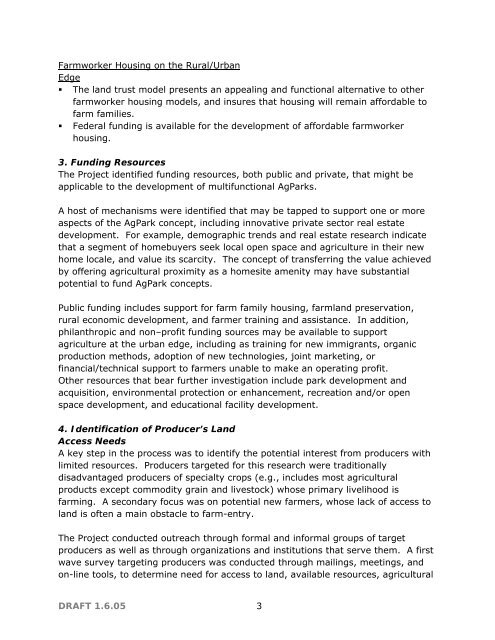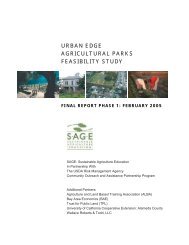A Feasibility Study for Urban Edge Agricultural Parks - SAGE
A Feasibility Study for Urban Edge Agricultural Parks - SAGE
A Feasibility Study for Urban Edge Agricultural Parks - SAGE
Create successful ePaper yourself
Turn your PDF publications into a flip-book with our unique Google optimized e-Paper software.
Farmworker Housing on the Rural/<strong>Urban</strong><strong>Edge</strong>• The land trust model presents an appealing and functional alternative to otherfarmworker housing models, and insures that housing will remain af<strong>for</strong>dable tofarm families.• Federal funding is available <strong>for</strong> the development of af<strong>for</strong>dable farmworkerhousing.3. Funding ResourcesThe Project identified funding resources, both public and private, that might beapplicable to the development of multifunctional Ag<strong>Parks</strong>.A host of mechanisms were identified that may be tapped to support one or moreaspects of the AgPark concept, including innovative private sector real estatedevelopment. For example, demographic trends and real estate research indicatethat a segment of homebuyers seek local open space and agriculture in their newhome locale, and value its scarcity. The concept of transferring the value achievedby offering agricultural proximity as a homesite amenity may have substantialpotential to fund AgPark concepts.Public funding includes support <strong>for</strong> farm family housing, farmland preservation,rural economic development, and farmer training and assistance. In addition,philanthropic and non–profit funding sources may be available to supportagriculture at the urban edge, including as training <strong>for</strong> new immigrants, organicproduction methods, adoption of new technologies, joint marketing, orfinancial/technical support to farmers unable to make an operating profit.Other resources that bear further investigation include park development andacquisition, environmental protection or enhancement, recreation and/or openspace development, and educational facility development.4. Identification of Producer’s LandAccess NeedsA key step in the process was to identify the potential interest from producers withlimited resources. Producers targeted <strong>for</strong> this research were traditionallydisadvantaged producers of specialty crops (e.g., includes most agriculturalproducts except commodity grain and livestock) whose primary livelihood isfarming. A secondary focus was on potential new farmers, whose lack of access toland is often a main obstacle to farm-entry.The Project conducted outreach through <strong>for</strong>mal and in<strong>for</strong>mal groups of targetproducers as well as through organizations and institutions that serve them. A firstwave survey targeting producers was conducted through mailings, meetings, andon-line tools, to determine need <strong>for</strong> access to land, available resources, agriculturalDRAFT 1.6.05 3





